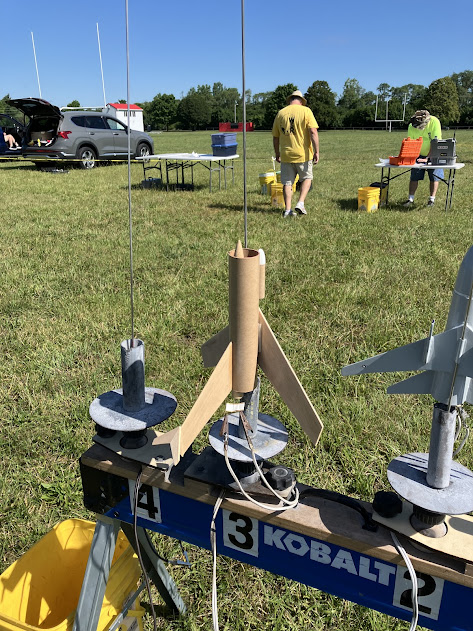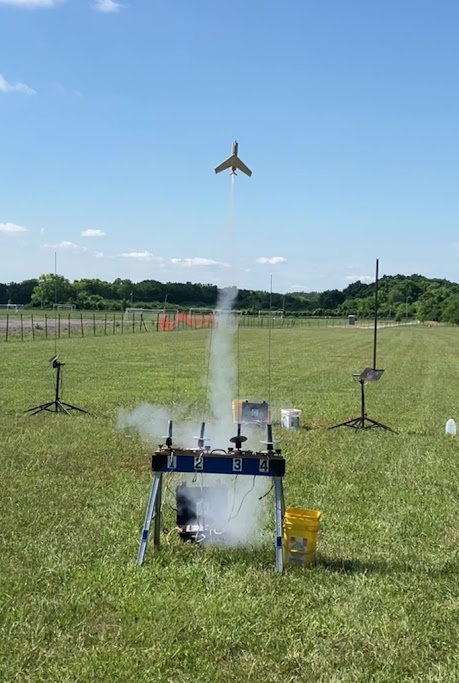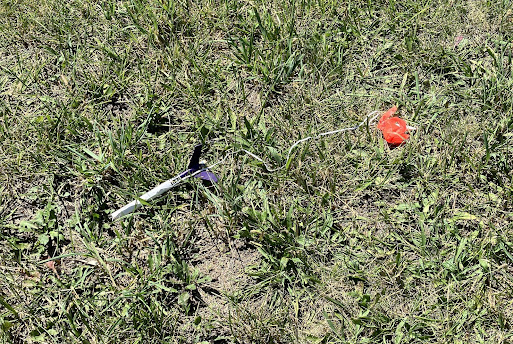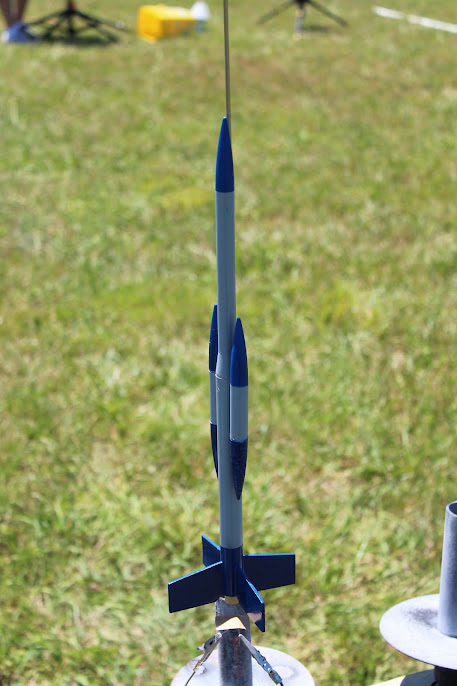I may have mentioned it before, but 2024 has been a nightmare from a flight standpoint. Through May of this year I had made 10 flights, six of which were at B6-4 Field. The other four were at club launches, which I drove a total of ten hours to attend. That's a 1 flight per hour average. I'm old, but not that old.
Sunday I finally got to attend a Wright Stuff Rocketeers launch without rain, cold or cancellation. It was the kind of day that reminds you what you enjoy about this hobby, even with destruction and the obligatory D12 CATO. I managed fourteen flights, nine of which were first time flyers. This thins out my unflown stash a lot, but I still have quite a backlog at home.
I decided to start the day off with something relatively unseen at the pads, the Inflight version of the venerable Centuri Mach 10. I'm kind of awash with Mach 10s, so much so that I had trouble figuring out one from another. I have an original and an early clone, but also two obvious clones that I couldn't tell apart. Various clues told me that the unpainted one was the Inflight kit while the white one was another of my homebrew concoctions. (More on that in future blog posts.)
The M10 was flight #2 on the day behind Mike Rohde's modified Estes Jetliner. (Mike now has a Cricut. Be forewarned.) The Mach 10 looked great going up, fired the marker cone at the 200' level, and attempted to transition to glide mode. Glide mode wasn't quite as stable as the hand toss had been in the side yard last week, but it kept trying all the way back to earth. All parts were recovered without damage, but more than half of the streamer for the marker cone was missing. I have no idea what happened there. It was not seen floating off.
Flight #2 was my long suffering Semroc Marauder. I ran into issues with this build when the motor mount in the sustainer dried slightly crooked, which kept the two stages from attaching correctly. I was able to "finagle" the two parts together, and spent the last week doing the finishing work, which I half-completed before the flight. Hence the half-finished look of the glamour shot.
I had this set up for a flight at B6-4 Field, so an A8-0/A8-5 flight. Luckily that flight never happened because I'd be shopping for a new sustainer. Despite staging not long after it cleared the rod, the Marauder would have WAY overflown B6-4 Field. As it was, it was a perfect flight for the Huber Heights field, likely around 600'. The booster recovered just beyond the mid-power pads, while the sustainer landed without damage fairly deep in the parking lot of the soccer complex.
The Estes Xarconian Cruiser was my next first flight bird on the day. This is a fairly complex build and the finished product is fairly heavy, even in primer, so I chose a C5-3 for the first flight.
The C5-3 turned out to be a good choice. The Cruiser is a bit on the tubby side. I can say that because I'm a bit on the tubby side, a solid rocketeer medium. The flight was as expected, leaving the pad with authority and a slight wind-cock right to around 700'. The C5-3 leaves no room for argument and makes me wonder about the need for a C6-3, which seems wheezy and lethargic by comparison. Even with the wind-cock, the recovery still occurred on the soccer parking, a hard hit that looked troublesome from the flightline. Other than some balsa dents there was no damage.
Flight #4 of the previously unflown would be the Estes Firebird. I obtained this one for mere pennies 20+ years ago via eBay. Memories of it are fuzzy, but I may have bid on it thinking it was the Firehawk. Oopsie. Like Forrest says, it happens. I did the honorable thing and paid my pennies, then let it sit in the shop being cannibalized for the next two decades. I recently had an occurrence where most of the fins and body tube were actually in the same stratosphere at the same time, so I took it as a sign from above and started construction. A new fin was cut to replace the missing one. The sticker decals were scanned and printed off as waterslides with varying degrees of success. Unless this was your first rocket there is very little here to get excited about, but when was the last time you saw one at the pads.
Since I was on a biggish field, I went with 60's hi-power, the C6-5. This is the kind of rocket that the C6-5 made its bones on, fairly light and sturdy. No wind-cock here. The flight was arrow straight to around 800' and ejection occurred.......wait, did it occur? The ejection charge sounded like a baby fart and no laundry was ejected as a result. The Firebird alternated between plunging headlong toward the turf and laying out flat and attempting to deploy the chute. It was not to be, and the whole mess crashed to the ground behind the mid-power pads. Post flight analysis showed the chute had deployed when it hit and that no damage resulted from the impact. Like I said. Sturdy.
To be honest, the next flight was one I was really looking forward to. I bought a lot of Estes Eliminators over the flying seasons, mostly because I saw the BT-56 become a memory and I wanted to have the capability to clone more Enerjet rockets. Then one day they were gone. So was my Enerjet 1340/20 clone, (lost at this very field.) This Eliminator was for sale on eBay in built condition, so I picked it up to have the opportunity to try and turn it into my next Enerjet 1340/20. However, before I started cutting, I found several lengths of BT-56 in my stash, so I decided to rebuild the Eliminator as Estes intended. Paint was handled with two unlabeled cans that I'd had forever, and a decal from one of the kits I'd used previously for my Enerjet clones.
I thought an e12 might overfly eRockets Field, so I opted for a D12-5 instead. Since the Estes recall involving the D12 was fresh in my mind, I fully intended to check to see if mine was one of the dates, but at some point during the drive to the field, I forgot. I remembered when the launch button was pressed, in fact, the whole flightline remembered. The Eliminator didn't much move up the rod before the CATO. Instead, the CATO blew it up the rod. Altitude was about 100' and the interior was crisped, but the nose cone and fin can were usable in the event that some new BT-56 tubing turns up.
Flight #6 was my first flight Estes Wizard that I'd converted to 13mm power, just because I had several 18mm Wizards already. (I went through a crisis of faith in the spring and converted several BT-20 rockets to 13mm. 13mm is much more B6-4 Field friendly in BT-20 birds.)
The Wizard flew on an A3-4T, and the flight was undistinguishable from any other Wizard flight. The flight topped out around 400' and it was still moving up when the ejection charge fired. It was high enough that no one heard the impact as the nose cone rebounded into one of the fins and knocked it off. The remainder of the Wizard crossed back over the field and landed hard on the soccer parking lot. No sign of the missing fin was found in the surrounding area, but it later turned up several hours later several hundred feet away.
Clearly I'd be transporting some damaged rockets home on this day.
Next on the pad was the half-finished Estes Antar. I could have sworn this one had never been flown, but it had done a launch in the beans back in April. Considering that I'd made all of four beanfield flights, it's tough to believe that I could forget one. That flight had been on a C6-5 and had clearly struggled, so this one would be on a C5-3.
Again, good call on the C5-3, as I don't build light and this is a fairly porcine build anyway. The Antar wind-cocked right and had just about stopped forward motion when the ejection charge fired. That was when I remembered that I wanted to reef the chute. Oopsie. It drifted back across the field in front of the flight-line and easily reached the soccer lot, hitting with a teeth-rattling impact and bouncing a foot into the air. I feared the worst, but there was barely a mark on the balsa. Tough little piggy, the Antar.
I was checking out the Estes kit list at YORF one day this spring when I noticed that the Estes Spartan was listed as a Mini-Brute. I liked the idea of a chunky BT-50 bird to stretch the sky at B6-4 Field a bit, so I headed down to the shop to see what parts I had that could start the project. As with all good hoards, I had everything needed, and the project was started and finished in under 24 hours. Even the paint job cooperated, all white on the body tube with a red nose cone. The part of the project that took longest was printing and prepping the decal.
At this point I had switched to my big camera because my phone was running low on power. As a result, all I got of the Spartan flight was it farting on the pad. The flight itself was as expected, a gently arc to the right and long drift out into the neighboring soccer field. As I headed out I was stopped by a fellow flyer who had sent his son out to pick up the Spartan when it drifted over them on their recovery walk, which saved me some steps for later. Boy, would I need them;
I picked up the Estes Surveyor via eBay several years ago. When I bought it, I was thinking that it was larger than it actually turned out to be. In my mind it was BT-50 based with BT-20 pods. It's actually tiny. The project languished in that half-finished, not quite flyable state for several years, but I got reinterested in the project when I noticed that it was among the kits that no one seemed to have any documentation on, so I started gathering everything back up, which took a while. This all coincided with my quest to turn some of my BT-20 birds to 13mm power to make them easier to fly at B6-4 Field, where an A8-3 flight in some rockets is WAY too much power these days. In the end, the Surveyor became a 13mm bird, and doesn't seem to have suffered for it.
I had a roll of vintage crepe streamer that came with an rBay lot years ago and I happened to have it in the range box, so I decided to use it for this flight. The A3-4T flight followed the script, a slight wind-cock to the right to around 400' and a gently streaming recovery out beyond the mid-power pads. It was definitely a streamer kind of day.
The Semroc Earmark was another eBay purchase, a completed body-in-white version of one of Carl's odder moments. This bird has made multiple trips to multiple fields and remained unflown, so it fit in nicely with my first flight theme for the day. By this point in the day I had been dealing with full sun all day and was a bit glare-blind, which explains the Earmark photo.
One thing I should have done when I packed this up was unfurl the streamer. Never gave it a thought until the whole mess was coming down in a wad and heading for the gravel of the soccer lot. The impact was hard and I expected the worst, but since I had sealed the edge of the fiber ear fins with CA, they were tough as nails and wound up no worse for wear.
Speaking of eBay purchases, the Astron Shrike was part of one of my earliest eBay lot wins. Yeah, it's hideous, but what kid didn't make do with whatever spray paint Mom had in the craft cabinet. The first time our neighborhood biked out to NKU for a launch, every bird in the bunch was painted in "colors at hand". The Shrike is the soul of that mindset. It last flew in 2002, so I recently got it back out and got it flightworthy, loaded a B6-0/B6-6 combo and tossed it in the travel box.
Turned out the B6 stack load was more than enough for conditions. The flight arced to the right and behind the flightline, topping out around 800'. It then rode the full chute back over us and made a slow run for the absolute edge of the park, somewhere around 1/2 mile away. We watched it drift away from us, fully expecting it to clear the fence and wind up in the thick brush across the road. Just when I thought all hope was lost, a truck passed on the road beyond the complex and the Shrike dropped to the gravel fifty feet away from sure doom. The recovery walk took forever and I found the Shrike safe but battered as a result of being dragged across the gravel by the winds. It will never look as pretty as it once was, but then again it never was. The end of the tube was battered and torn, nothing a little judicious trimming won't take care of should I decide to go that route. As it is, I have a Semroc Shrike approaching finished status, so the Astron version probably won't have too many flight opportunities left.
Proximity to the road.
The distant flightline. I toasted the successful flight with a cold Power-Ade. And boy, did I need it.
The Estes Eclipse flew for years at B6-4 Field on A8-3s, but I noticed that in actuality it was supposed to be a Mini Brute when I made a list of potential MB projects. Better late than never, it was retrofitted with a 13mm engine mount. This would be the first MB flight.
Okay, I know. If I'm going to keep doing this, I'm going to have to invest in a new point and shoot camera. I found one with a 10 frame per second burst rate that I'm going to test out when I can make myself spend money. Cut me a break. I also need to think about a Cricut. Yep, another pic of a rocket getting gassy on the pad. The big Canon is a great one for scenery and people, and produces some pretty impressive rocket glamour shots, but the burst rate is as slow as a 38 year old career catcher on the basepaths. The A3-4T flight was excellent, perfect for conditions and right on the edge of what B6-4 Field could stand. (A 1/2A would be perfect.) The flight was the daily standard, wind-cock to the right, top out around 400', and a streamer recover back across the field near the soccer lot.
One of the more recently flown rockets on the day was the PDR SS Cassiopeia, but this would be the first flight since the paint and decals were finished. This is a troublesome flyer that always seems to incur damage, usually to the attachment points for the ring fin.
This was a C6-5 flight because I wanted to. When I picked it out of the box it had a B6-4 loaded for service at B6-4 Field, which would have been a mistake. I swapped in the C6-5 because I felt the field called for it. All I got of the flight is another shot of a rocket sitting and breaking wind on the pad. The C6-5 flight was probably WAY too much for conditions because the winds had really kicked up. The Cassiopeia wind-cocked right as it left the pad and flew to around 900'. Everything worked as expected at ejection and it began a quick drift back across the flightline, eventually making hard contact with the equally hard ground of one of the soccer fields. It bounced at contact, which is normally never good. Mike Rohde was there to gather things up and as I was walking up I mentioned that it looked like the kind of flight that winds up with some damage. Mike pointed back to the point of impact where the ring fin was sitting. All was right in my kingdom.
My 14th and final flight on the day was the Centuri Sky Devil. It was in my traveling box because I had taken it to several launches at B6-4 Field, which was why it was loaded with an A8-3. I had a B6-6 in the box but decided to just go with the A8-3 to cut down on the recovery walk.
The range was being struck around me, but I still had rockets loaded and ready and half a cooler of Power-Ade. I probably should have sent up The Whopper, a modified Mini Fat Boy, but the Sky Devil was right on top of the box and had been waiting longer for flight glory. Loaded with an A8-3 for use at B6-4 Field, (it could easily stand a 1/2A6-2 or even a mini adapter,) the flight was the usual, blown slightly right off the pad with a recovery in the gravel of the soccer parking lot. This one did incur some damage, a fin that snapped in half on impact with the rocks. No surprise there.
From here we packed up and were off the field and on the road within fifteen minutes. The drive home had me thinking of my first launch in 1977 at a parking lot at Northern Kentucky University. We'd ridden our bikes there with our whole launch complex strapped to our ten speeds. The ride home that day was much the same as this one. I felt hot and gritty and wanted nothing more than a shower and a drink, but I'd flown, and all I wanted to do was tell someone about it. Like I said, much the same as this one.















.jpg)
































Great launch report! I’m usually the “frequent flyer” at our club launches but last time I spent a good chunk of time helping out some youngsters flying their first rockets so fun to see someone else put over a dozen rockets in the sky😎
ReplyDeleteI don't really count as I go at a launch, but I pack heavy and prep the night before. That way if conditions are favorable, I'm going to put a lot of rockets on the pad. This time I was going to be among the most frequent just based on how long it had been since the last time I flew and that the crowd was surprisingly small for such a perfect day.
Delete